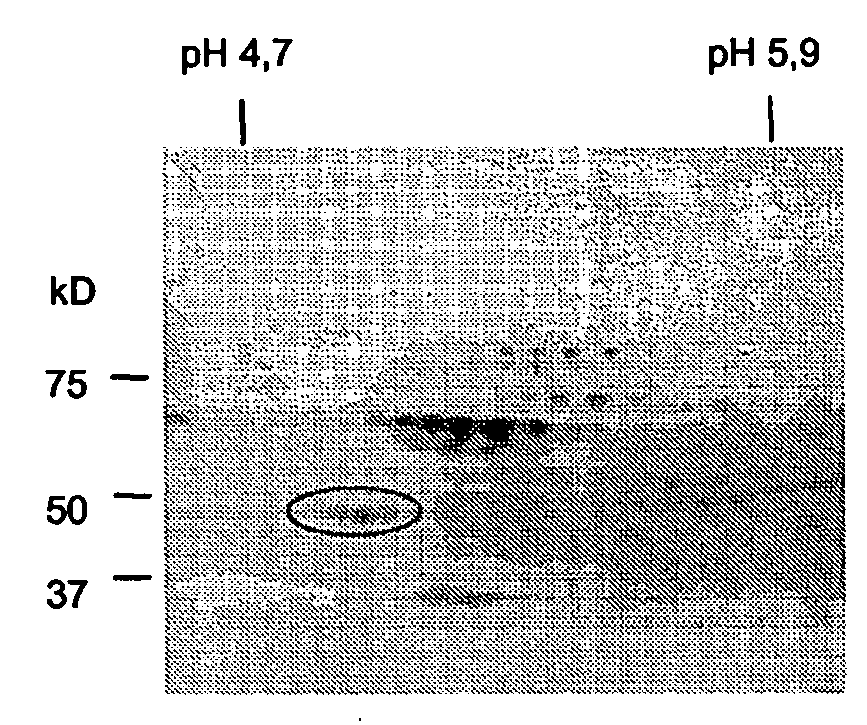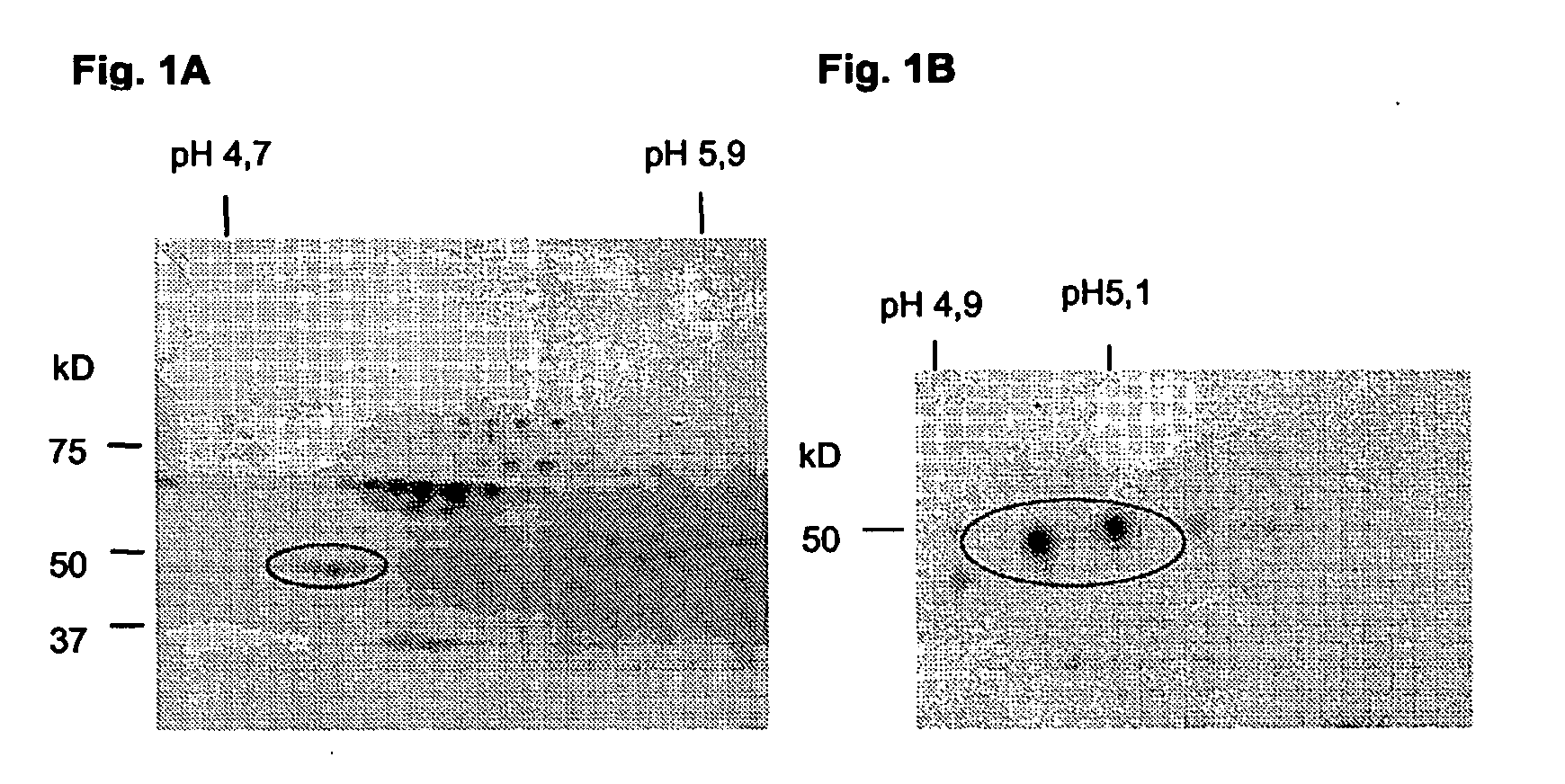Method for the identification of atypical p-anca
a technology of atypical p-anca and atypical p-anca, which is applied in the field of atypical p-anca identification, can solve the problems of failure of mass spectrometry tests performed by the inventors of the present application to identify the reactive protein by mass spectrometric techniques, and the inability to detect the reaction with atypical p-anca-negative sera of healthy test persons, and achieve the highest diagnostic precision and high diagnostic precision
- Summary
- Abstract
- Description
- Claims
- Application Information
AI Technical Summary
Benefits of technology
Problems solved by technology
Method used
Image
Examples
example 1
Patient Sera for the Identification of the Target Antigen of Atypical p-ANCA
[0128]In this study, serum samples of 37 patients with autoimmune liver diseases (primary sclerosing cholangitis [PSC] n=7, autoimmune hepatitis [AIH] n=30) and sera of 5 healthy control persons have been used. Until being used, all sera were stored at a temperature of −20° C.
[0129]The diagnoses of the patients were based on established, clinical, endoscopic, histological, radiological, and serological criteria (Angulo, P. et al., J. Hepatol. 32:182-187 (2000); Wiesner, R. H., in: Krawitt, E. L et al., Hrsg., Autoimmune Liver Diseases, 2nd Ed., Amsterdam, Elsevier, 381-412 (1998)). The activity level of the disease for PSC and AIH was determined by established measuring values based on clinical data and laboratory data like the “Mayo Risk Score” for primary sclerosing cholangitis (Kim, W. R. et al., Mayo Clin. Proc. 75:688-694 (2000)) and the “Scoring System for the Diagnosis of Autoimmune Hepatitis”, sugges...
example 2
Culture of Promyelomonocytic HL-60 Cells and Other Cell Cultures
[0131]Human promyelomonocytic HL-60 cells (Deutsche Sammlung von Mikroorganismen und Zellkulturen GmbH (DSMZ) [German Resource Center for Biological Material], Braunschweig; ACC-3) were cultivated in RPMI medium (PAA, Pasching, Austria) with 10% (v / v) heat inactivated fetal calf serum at 5% of CO2 and a temperature of 37° C. (Collins, S. J. et al., Nature 270:347-349 (1977)). Since more than 50% of the cells spontaneously differentiated into mature granulocytes, a chemical induction of the differentiation, for example with 1% (v / v) dimethylsulfoxide, over 4-6 days was renounced.
[0132]The following myeloid differentiated cell lines can be used as an alternative to HL-60 cells: Murine 32 D cells, U937, K-562. Some experience with murine 32 D cells have been made in the scope of the first protein-chemical experiments (Terjung, B. et al., Gastroenterology 119:310-322 (2000)). Due to the limited availability and the comparat...
example 3
Production of Nuclear Envelope Extracts from HL-60 Cells
[0135]The production of the nuclear envelope extracts followed the modified standard protocols (Gerace, L. et al., J Cell Biol 95:826-837 (1982); U.S. Pat. No. 6,627,458; Dwyer, N. et al., J. Cell Biol. 70:581-591 (1976); Gerace, L et al., J. Cell Biol. 95:826-837 (1982)). Here, the harvested cells were incubated in hypotonic lysing buffer (10 mM Tris HCl, pH value 7.5; 1 mM of MgCl2; 1 mM of dithiothreitol) which has been mixed with proteinase inhibitors (1 μg / ml of aprotinin, bacitracin, benzamidin, leupeptin, pepstatin). Subsequently, the cell membranes and the nuclear membranes have been disrupted with a Pestle Homogenisator (Fisher Scientific, Pittsburgh, USA). To separate the nuclei from the cytoplasmic parts of the HL-60 cells, the cell suspension has been underlayered with 30% (w / v) sucrose and ultracentrifugated (35,000 rpm, 60 min.). The pellet containing the nuclei was incubated in a nuclear extraction buffer (20 mM ...
PUM
| Property | Measurement | Unit |
|---|---|---|
| Concentration | aaaaa | aaaaa |
| Molecular weight | aaaaa | aaaaa |
| Fluorescence | aaaaa | aaaaa |
Abstract
Description
Claims
Application Information
 Login to View More
Login to View More - R&D
- Intellectual Property
- Life Sciences
- Materials
- Tech Scout
- Unparalleled Data Quality
- Higher Quality Content
- 60% Fewer Hallucinations
Browse by: Latest US Patents, China's latest patents, Technical Efficacy Thesaurus, Application Domain, Technology Topic, Popular Technical Reports.
© 2025 PatSnap. All rights reserved.Legal|Privacy policy|Modern Slavery Act Transparency Statement|Sitemap|About US| Contact US: help@patsnap.com



